Indian Gooseberry is also known as Amla or Aonla. It is a very popular medicinal plant. It is a wild deciduous tree that can grow up to 20 meters tall. The Indian Gooseberry tree has a smooth, brown bark. The leaves are like tamarind trees or ferns, tall but narrow, up to 2 cm, and the flowers are indistinct because they are green in color. The flowers are unisexual and appear in clusters. The fruits are small, up to 3 cm in diameter, greenish-yellow color, and turn orange-brown after ripening. Let’s find out
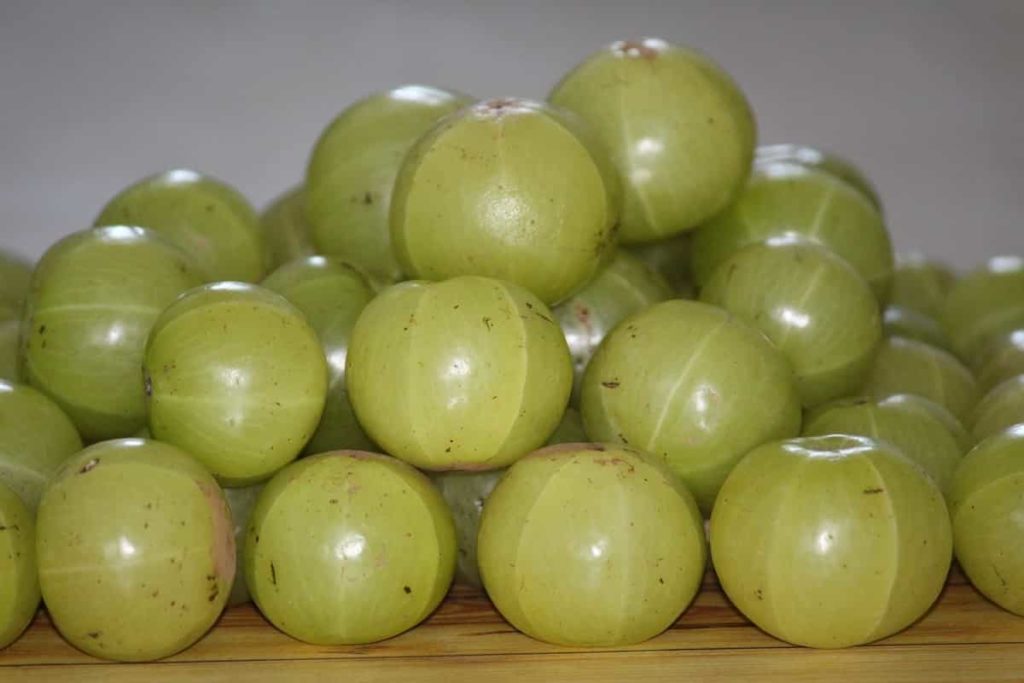
Top 15 steps to boost Indian Gooseberry/Amla yield
Step 1: Soil management for plant growth
Light and medium-heavy soils are best for plant growth. Avoid pure sandy soils. The tree adapts well to dry areas and can be grown in mild alkaline soils. It is highly tolerant of salinity and sodicity and is cultivated very successfully in the pH range of 6.0 to 8.0. However, its production is higher in deep and fertile soils. Due to its complex nature, it is grown in various soils. It is produced in slightly acidic saline soils and can be grown in calcareous soils. It gives the best results when grown under fertile clay with a good drainage system. It can also tolerate mild alkaline soils. Avoid cultivating in heavy soils.
Step 2: Location and climate for planting Indian Gooseberry
Indian Gooseberry is planted with strong wind and less sun. The well-drained and dirty position is suitable for its growth. It is a tropical plant. 630-800 mm annual rainfall is ideal for its development. Young plants up to 3 years old should be protected from hot air during May and June and frost in winter. Mature plants can withstand freezing temperatures and high temperatures up to 46°C.
Step 3: Select high yield varieties
Different high yield varieties are Banarasi, Chakaiya, Francis, NA-4 (Krishna), NA-5 (Kanchan), NA-6, NA-7 (Promising variety), NA-10, and BSR-1 (Bhavanisagar). Champakkad Large is an Indian Gooseberry variety found in the Western Ghats and is suitable for Kerala cultivation. Champakkad Large yields large fruits. Banarasi, which is taller, is also ideal for Kerala. The berries are large and can be divided into three parts. It can weigh up to 38 grams. Krishna and Kanchana are other varieties.
Step 4: Land preparation to improve crop production
Indian Gooseberry requires good plowing and organic soil for cultivation. To bring the soil into fine tillage, shake the soil before planting. Organic fertilizers such as FYM are added to the soil. Then the nursery beds are made 2.5 cm deep and 15 cm x 15 cm in size.
In case you missed it: Amla Farming Income (Indian Gooseberry/Usiri)
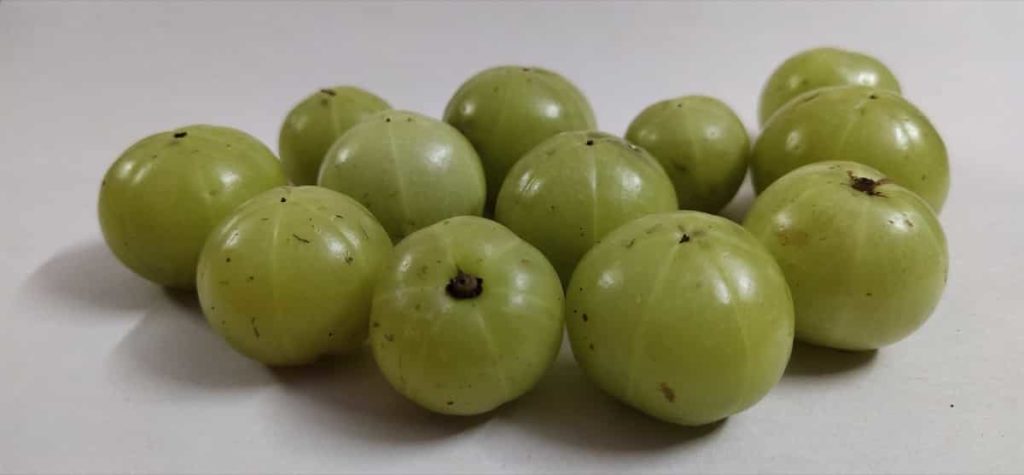
Step 5: Seed rate and seed treatment for good growth
Use a seed rate of 200 grams per acre for good growth. To protect the crop from soil-borne diseases and pests and for better germination, the seeds are treated with Gibberellic acid by 200-500ppm before sowing. After chemical treatment, the seeds are air-dried.
Step 6: High-density planting for improving crop yield
Indian Gooseberry is a hardy, drought-tolerant crop. Therefore, it lends itself to planting high-density plants even in marginal and wastelands. Through systematic pruning techniques, grafted trees of higher-yielding varieties can be maintained as highly effective shrubs, and such shrubs are ideally suited for high-density planting. High-yielding Indian Gooseberry varieties such as NA-7, Krishna, and Chakia are especially suitable for close planting with a spacing of 3 meters by 3 meters.
1200 plants can be planted in a hectare by adopting this spacing and following the hexagonal or triangular method of planting. In addition, some shade-tolerant medicinal plants like Phyllanthus sp (Keelanelli) and Nutmeg can be grown as intercrop till Indian Gooseberry trees reach the age of economic tolerance. High-yielding varieties of good quality and healthy yield were planted in well-prepared fields. Small pits of 30 cm x 30 cm x 30 cm were filled with good organic manure, neem cake, and vermicompost mixed with increasing soil water retention capacity.
Biofertilizers like Phosphobacterium, Azotobacter, and Vesicular Arbuscular Mycorrhiza (VAM) are used regularly to enhance plant growth. Initially, the drip system delivered 25 liters per plant per day (depending on the soil moisture method). However, after the first year of growth, when grafts have brought down the invasive and extensive root system, each plant will need only 25 liters once a week, even in hot summers.
Plants are pruned regularly, and young plants can bear fruit. However, economically viable and large fruits can be obtained from the third year of planting. Each plant will bear about 25 kg of fruit in a year. The yield will increase to 50 kilograms per year when the trees are five years old. After the eighth year, the average yield per tree will be about 100 kg per year.
In case you missed it: Amla Cultivation Project Report, Economics Guide
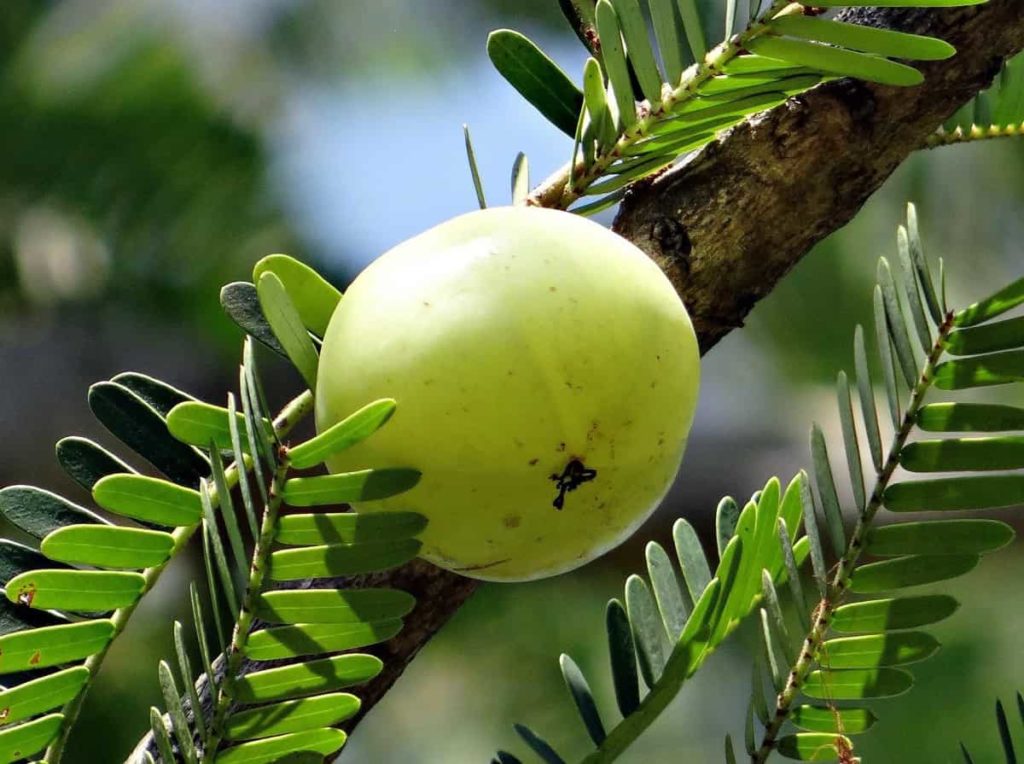
Step 7: Propagation and planting tips for improving crop yield
Indian Gooseberry grows from seed, germinating strongly and growing quickly. Unfortunately, though, it takes 7 to 10 years to give this result. You can grow this tree by budding or air layering. You can also bring a healthy plant near the nursery. Indian Gooseberry grafts or budding are best planted in June to early July. Plants can also be planted in irrigated areas in spring (February to March).
The field should be carefully plowed, leveled, and marked before planting. The 13-meter size pits are well made in summer, are kept open for about one fortnight, and each hole is filled with 10-15 kg FYM level soil. After the first shower, the plants are planted in the middle of these pits and adequately watered.
Step 8: Watered regularly for good growth
The tree dries out during the first two years but needs to be watered regularly. But don’t let the soil get wet constantly. During spring and summer, it needs water in the growing season, and give it plenty of water once in 15 to 20 days. Sprinkler irrigation is applied every week. It does not need water in winter and autumn.
Step 9: Training and pruning to encourage crop growth
Other dead, diseased, weekly crossing branches and sucking branches should be pruned in late December, leaving only 4-5 well-shaped branches with a wide-angle of about 0.75 meters above ground level. Tree pruning is helpful to keep it in shape and control it in December or January each year in the tropics and the subtropics in the spring. All dead, damaged, diseased branches or those that are tangled with each other should be removed from time to time. If the tree begins to bear less fruit, cut it down to about five feet in the spring to revive it.
In case you missed it: Amla Farming (Indian Gooseberry), Planting, Care
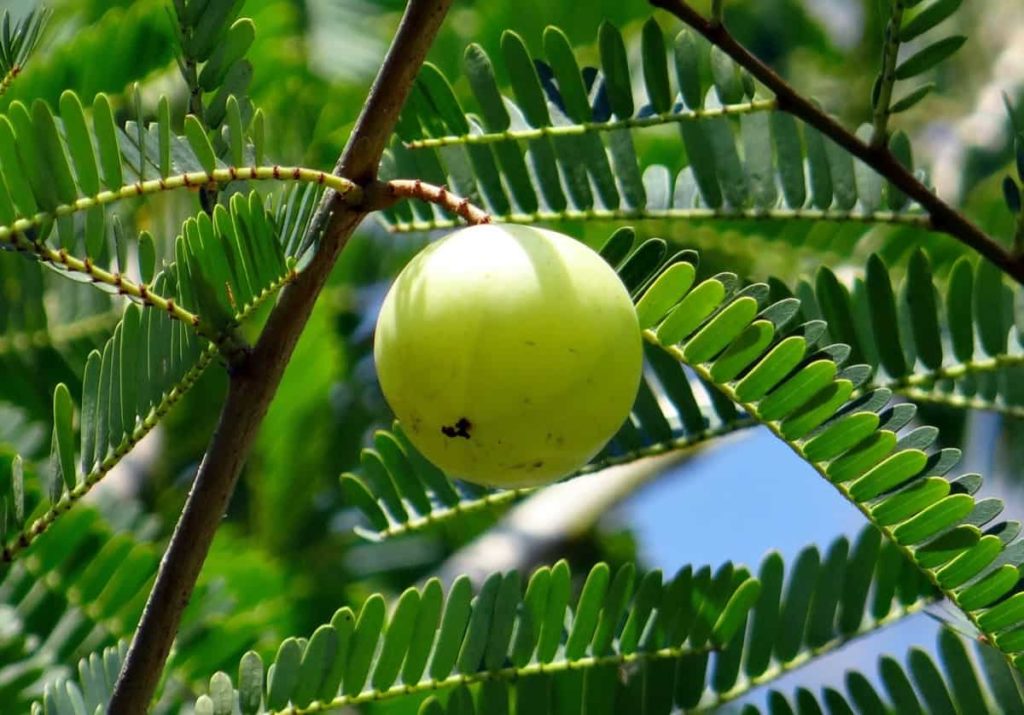
Step 10: Mulching and intercropping improve crop yield
In summer, the crop should be mulched with wheat straw, paddy straw, or dry leaves of any tree should be placed 15-20 cm from the trunk at the tree’s base. Crops of small size and height like Green Gram, Black Gram, Cow Pea, Horse Gram, or any other medicinal, aromatic, or floriculture crops can be grown. The Indian Gooseberry tree is a very fast-growing species. However, in the first 3 to 4 years, there is ample space available that can be used in a beneficial way to grow intercrops.
Since this crop does not require any irrigation as the fruits are dormant in summer, it can be produced only during the rainy season or in the post-monsoon period, providing irrigation facilities. For this, Legume and vegetable crops can be taken as intercrop. Intercropping means managing the soil to maintain productivity and minimize soil loss. Techniques should be consistent with crop behavior.
Flowering occurs in February, and after fruiting, the fruits remain dormant until the summer monsoon, when the fruits begin to grow and are ready for harvest in December / January, depending on the climate of the place. Therefore, the soil should not be disturbed in summer, and natural cover may be allowed. Then, the basin can be cleaned at the beginning of the monsoon, fertilizer, and food can be used, and the space between the rows can be brought under green manure.
Step 11: Plant care tips for getting more yield
At the end of the first year, 20 kg FYM equals 30 grams nitrogen and should be applied. An additional 30 grams of N should be added each year as the tree grows. Forbearing tree, use 800 grams N, 640 grams P2O5, 750 grams K2O each year in the rainy season with 30-40 kg FYM. This feed can be divided into two equal portions; one half is applied from April to May (on the fruit set) and during irrigation. The remaining half can be given between September and October.
Care should be taken to ensure that peaks do not form until they reach a height of one meter. It is necessary to destroy the shoots growing from the bottom. Excess shoots should be removed in March-April. In orchards, cassava can be grown as an intercrop during the growing season, lasting for four to five years. The soil should be watered periodically in the early stages of development, depending on moisture. Although mature trees are not watered by default, watering at 15-day intervals from April to May will help the fruit look good and prevent ripening.
In case you missed it: Fast-Growing Shade Trees – In India
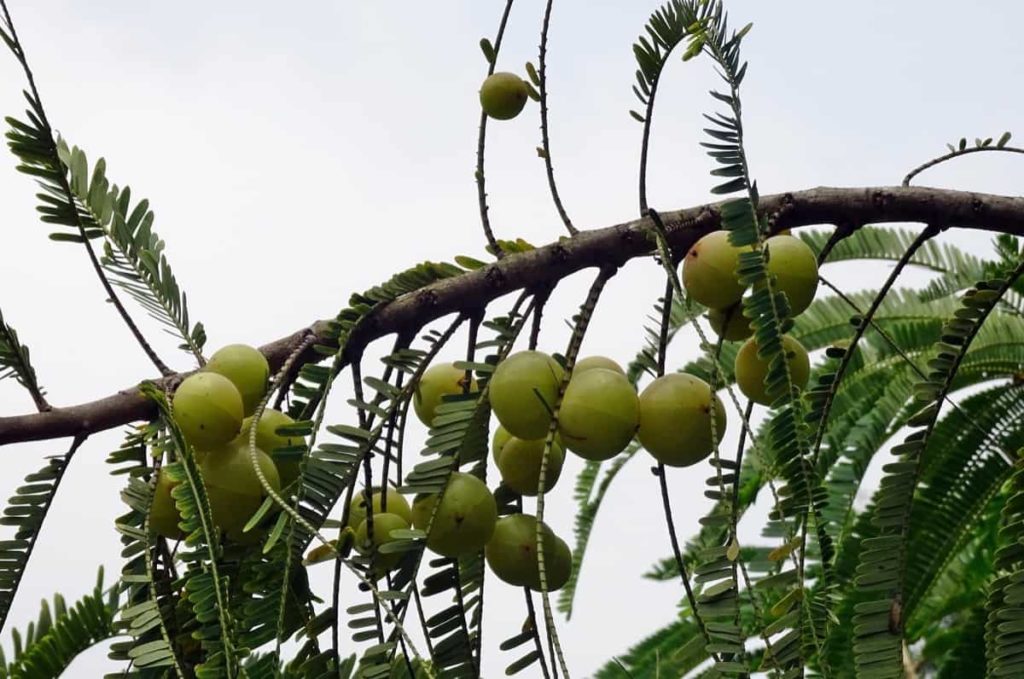
The trees begin to bear fruit in three to four years. But it can take 10 to 12 years to get consistently good yields. Fruits ripen for harvest in January-February. Repeat weeding to keep the field free of weeds. Training and pruning are also done. The Crisscross branches are cut off, and only 4-5 straight branches are left to grow further. Mulching is also an effective method to control soil weeds. In summer, mulching is done 15-10 cm from the tree’s base.
Step 12: Flower and fruit drop causes and their control
Flowering occurs on specific shoots that appear in spring. There is no self-incompatibility in Indian Gooseberry, and a poor fruit set (12-18%) may be due to a high percentage of staminate flowers. Flower and fruit drop in Indian Gooseberry is divided into three stages.
- The ‘first drop’ is the highest because 70% of the flowers fall off within three weeks of flowering due to non-fertilized ovary and degenerated ovules.
- The ‘second drop’ occurs from June to September, consisting of young fruit droplets due to a lack of pollination and fertilization during dormancy break.
- The ‘third drop’ extends from August to October during rapid growth due to a lack of auxins, i.e., embryological and physiological factors.
Step 13: Applying fertilizer to improve fruit quality
Provide fertilizer with 1 to 1/2 ounce of nitrogen every year of tree age. If you make it yourself at home, you should use organic fertilizer. Regularly caring for Indian Gooseberry is rare, so nutrition is hardly practiced. Beneficial effects of nitrogen, phosphorus, potash, zinc, copper, manganese, and boron have been recorded for crop growth. Nitrogen enhances plant growth and substance flowering, while phosphorus increases early set, fruit retention and yield, total soluble solids (TSS), and vitamin C.
Potassium fertilizer enhances fruit retention and quality. Therefore, young plants should be given 15-20 kg of well-decomposed fertilizer, and mature tree needs 30-40 kg every year from September-October. In addition, for plants up to 10 years of age, 30 grams of nitrogen and then 680-700 grams of nitrogen per tree per year should be provided.
Each adult tree should also be fertilized with 1 kg of superphosphate and 1-1.5 kg of Muriate of Potash. The above fertilizers should be applied to two equal amounts of fruit trees, once during September-October and April-May after fruiting. Plants need irrigation after fertilization. Foliar spray of 0.6% borax at intervals of about 10-15 days in September and October and recommended for controlling the fruit neck, which is caused due to lack of boron.
Step 14: Diseases and Insects control tips
Diseases and pests are rare in Indian Gooseberries. Common problems are rotting and mold growth. Fruits are kept in saline solution to control this problem. Kerosene can be applied to insect-infested areas to prevent wood-eating worms. To control nematodes, neem oil at 30 ml per liter or neem seed extract at 50 ml per liter can be sprayed.
In case you missed it: Intercropping In Fruit Crops – In India
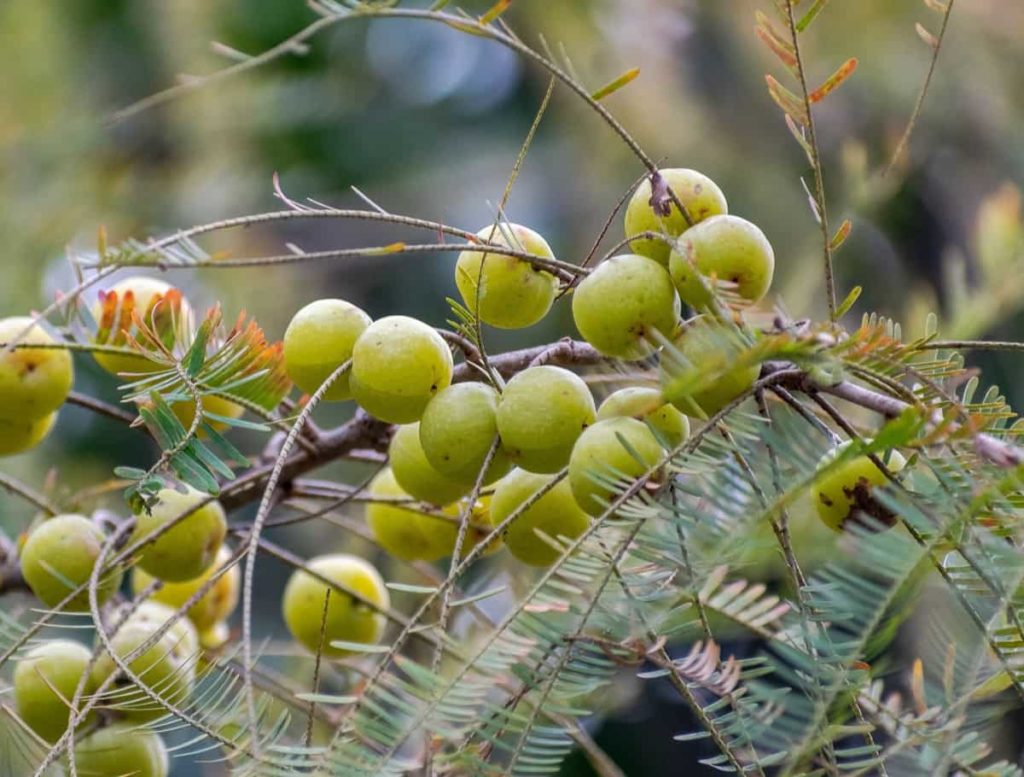
Step 15: Harvesting tips for more yield
Indian Gooseberry plants start producing fruits after 7-8 years of age. In the beginning stage, the fruit is light green, and as it matures, it turns green to yellow. The highest fruit production is in February. Ripe fruits are hardy and do not stumble. Use a tall bamboo hook to cut the fruit. Indian Gooseberry plants start to grow very late.
Typically, propagated trees begin to produce commercial crops 6-8 years after planting, whereas seeded trees may take 10-12 years to start commercial effect. The productivity of trees is estimated to be 50-60 years under good management conditions. Ripe fruits are hard and do not fall off with a soft touch, so they must be shaken vigorously.
- How to Make Houseplants Bushy: Effective Tips and Ideas
- Innovative Strategies for Boosting Coconut Pollination and Yield
- Pollination Strategies for Maximum Pumpkin Yield
- The Complete Guide to Chicken Fattening: Strategies for Maximum Growth
- Natural Solutions for Tulip Problems: 100% Effective Remedies for Leaf and Bulb-Related Issues
- Revolutionizing Citrus Preservation: Towards a Healthier, Greener Future
- Natural Solutions for Peony Leaf and Flower Problems: 100% Effective Remedies
- Maximizing Profits with Avocado Contract Farming in India: A Comprehensive Guide
- Natural Solutions for Hydrangea Problems: 100% Effective Remedies for Leaf and Flowers
- The Ultimate Guide to Choosing the Perfect Foliage Friend: Bringing Life Indoors
- From Sunlight to Sustainability: 15 Ways to Use Solar Technology in Agriculture
- The Ultimate Guide to Dong Tao Chicken: Exploring from History to Raising
- The Eco-Friendly Makeover: How to Convert Your Unused Swimming Pool into a Fish Pond
- Mastering the Art of Delaware Chicken Farming: Essentials for Healthy Backyard Flocks
- 20 Best Homemade Fertilizers for Money Plant: DIY Recipes and Application Methods
- How to Craft a Comprehensive Free-Range Chicken Farming Business Plan
- Brighten Your Flock: Raising Easter Egger Chickens for Beauty and Bounty
- How to Optimize Your Poultry Egg Farm Business Plan with These Strategies
- Subsidy for Spirulina Cultivation: How Indian Government Schemes Encouraging Spirulina Farmers
- Ultimate Guide to Raising Dominique Chickens: Breeding, Feeding, Egg-Production, and Care
- Mastering the Art of Raising Jersey Giant Chickens: Care, Feeding, and More
- Ultimate Guide to Raising Legbar Chickens: Breeding, Farming Practices, Diet, Egg-Production
- How to Raise Welsummer Chickens: A Comprehensive Guide for Beginners
- How to Protect Indoor Plants in Winter: A Comprehensive Guide
- Ultimate Guide to Grow Bag Gardening: Tips, Tricks, and Planting Ideas for Urban Gardeners
- Guide to Lotus Cultivation: How to Propagate, Plant, Grow, Care, Cost, and Profit
- Agriculture Drone Subsidy Scheme: Government Kisan Subsidy, License, and How to Apply Online
- Ultimate Guide to Raising Araucana Chickens: Breed Profile, Farming Economics, Diet, and Care
- Bringing Hydroponics to Classroom: Importance, Benefits of Learning for School Students
- Ultimate Guide to Raising Polish Chickens: Breed Profile, Farming Economics, Diet, and Care
- Ultimate Guide to Raising Australorp Chickens: Profile, Farming Economics, Egg Production, Diet, and Care
- Silkie Chicken Farming: Raising Practices, Varieties, Egg Production, Diet, and Care
- Sussex Chicken Farming: Raising Practices, Varieties, Egg Production, Diet and Care
- Homemade Feed Formulations for Livestock: Discover Cost-effective Starter to Finisher Feed Recipes
- 20 Best Pig Weight Gain Supplements: Top Swine Weight Gain Formulas
- Ultimate Guide to Elderberry Farming: Propagation, Planting, Yield, Cost, and Profit